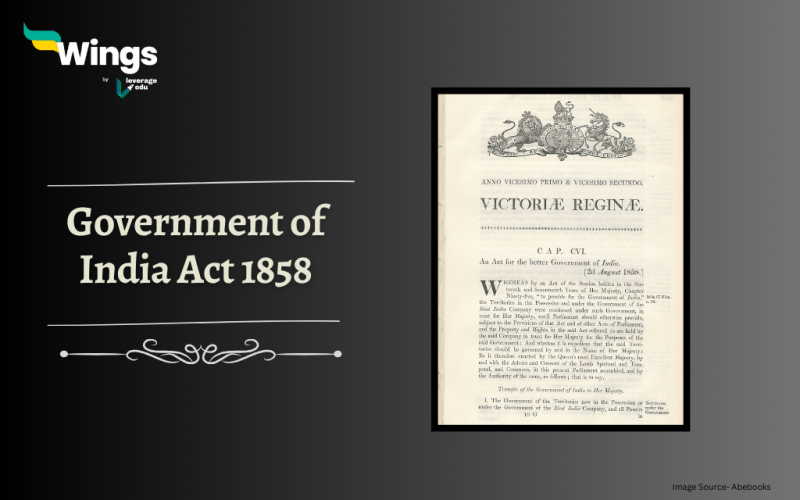The Government of India Act 1858, also known as the Act for the Better Government of India, marked a turning point in the history of India. The act was passed by the British Parliament in the wake of the Indian Rebellion of 1857, also known as the Sepoy Mutiny. This act abolished the powers of the East India Company and transferred the control of India from the company to the British Crown. It brought about sweeping changes in the governance and administration of the country. Let’s delve into the history, features, and aims of the act that shaped the course of Indian history.
Table of Contents [show]

Fun Fact
Queen Victoria, the monarch of Britain became the sovereign of British Territories in India.
She was titled as “ Empress of India”
What was the Background of the Government of India Act 1858?
- The East India Company: Before the act, the East India Company was granted a royal charter in 1600, which allowed it to trade with the Indian subcontinent. Over time, the company gained control over vast territories, establishing its own administration in India.
- Sepoy Munity: The uprising against the East India Company, known as the Indian Rebellion of 1857, highlighted the mismanagement and oppressive rule of the company. This rebellion played a significant role in the passage of the Government of India Act 1858.
- The Act’s Passage: In the aftermath of the rebellion, the British Parliament passed the Government of India Act 1858. The act was introduced by British statesman Sir Charles Wood and later adopted by the Parliament.
Also Read – The Government of India Act 1919
Features of the Government of India Act 1858
- Abolition of the East India Company’s Rule: The act abolished the rule of the East India Company and transferred the authority to govern India to the British Crown. This marked the beginning of direct British control over the Indian subcontinent.
- Creation of the Secretary of State for India: The act established the position of the Secretary of State for India, who was a member of the British Cabinet. The Secretary of State became the principal authority responsible for governing India and advising the British monarch on Indian affairs.
- Establishment of the Indian Civil Service: The act introduced the Indian Civil Service, a respected administrative body comprising British officials who would govern India. This further centralized British control.
- Reorganization of Provinces: The act reorganized the administrative divisions of India and divided the country into provinces, presidencies, and agencies. This helped streamline governance and establish a more uniform system.
- Protection of Indian Courts and Judicial System: The act guaranteed the protection of Indian courts and established a hierarchical structure for the judicial system. It aimed to maintain the existing legal framework while incorporating British influence.
The dual system which was introduced by the Pitt’s India Act was abolished and it also ended the Doctrine of Lapse.
Also Read – Government of India Act 1935: Key Features, Significance and More
Aim of the Government of India Act 1858
- Centralized Control: The act aimed to establish centralized control over India by transferring power from the East India Company to the British Crown. This was seen as a necessary step to prevent further mismanagement and ensure more effective governance.
- Modernization and Reform: The act sought to modernize and reform various aspects of Indian administration, such as the judicial system and governance structure. It aimed to bring in British ideals and practices while maintaining some elements of Indian tradition.
- Consolidation of British Rule: By establishing a clear chain of command, expanding legislative powers, and reorganizing administrative divisions, the act aimed to consolidate British rule in India. It provided a framework for British officials to exercise their authority with less interference from the East India Company.

The first Secretary of State for India was Lord Stanley and the first Governor-General and Viceroy of India was Lord Canning. By abolishing the rule of the East India Company and transferring control to the British Crown, it marked a significant shift in power. The act aimed to centralize control, modernize systems, and consolidate British rule. Its impact can still be seen in the administrative and legal structures of India today.
Relevant Blogs
| What was the Lucknow Pact? | Charter Act 1833 |
| Indian Councils Act 1909 | Charles Wood’s Despatch |
| Charter Act 1813 | Charter Act 1853 |
| Complete List of Governor General of India | Full List Of Viceroys Of India |
That’s all about the Government of India Act 1858! If you want to know more about topics like this, then visit our general knowledge page! Alternatively, you can also read our blog on general knowledge for competitive exams!
 One app for all your study abroad needs
One app for all your study abroad needs















 45,000+ students trusted us with their dreams. Take the first step today!
45,000+ students trusted us with their dreams. Take the first step today!
